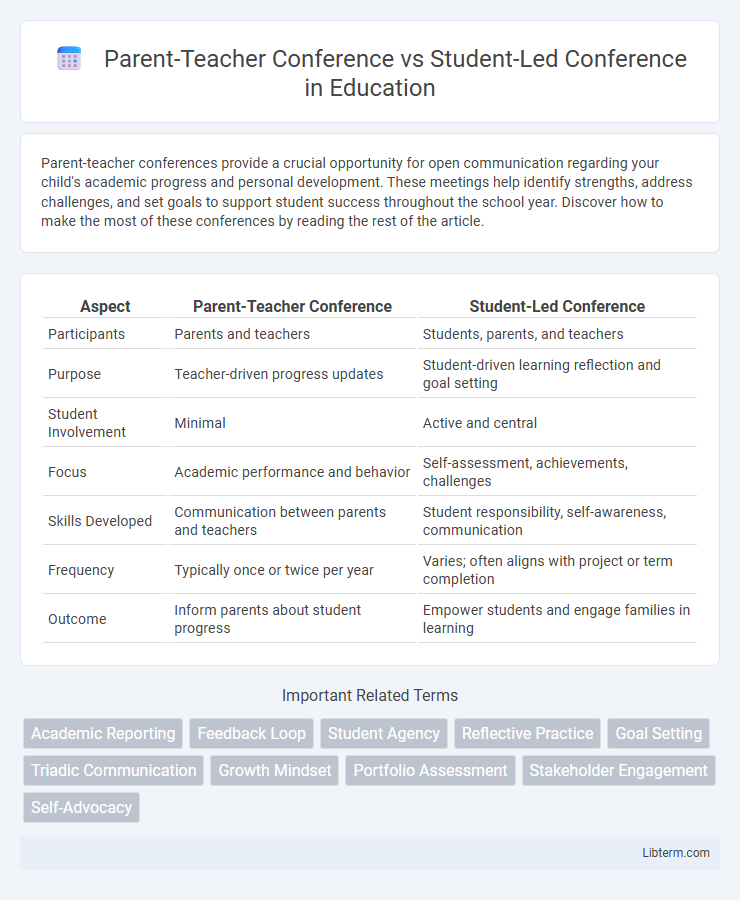Parent-teacher conferences provide a crucial opportunity for open communication regarding your child's academic progress and personal development. These meetings help identify strengths, address challenges, and set goals to support student success throughout the school year. Discover how to make the most of these conferences by reading the rest of the article.
Table of Comparison
| Aspect | Parent-Teacher Conference | Student-Led Conference |
|---|---|---|
| Participants | Parents and teachers | Students, parents, and teachers |
| Purpose | Teacher-driven progress updates | Student-driven learning reflection and goal setting |
| Student Involvement | Minimal | Active and central |
| Focus | Academic performance and behavior | Self-assessment, achievements, challenges |
| Skills Developed | Communication between parents and teachers | Student responsibility, self-awareness, communication |
| Frequency | Typically once or twice per year | Varies; often aligns with project or term completion |
| Outcome | Inform parents about student progress | Empower students and engage families in learning |
Understanding Parent-Teacher Conferences
Parent-teacher conferences facilitate direct communication between educators and parents to discuss a student's academic progress, behavior, and areas for improvement. These meetings provide teachers with the opportunity to share detailed assessments and personalized strategies to support the student's learning. Unlike student-led conferences, parent-teacher conferences rely primarily on the teacher's insights rather than the student's active participation in the discussion.
What Are Student-Led Conferences?
Student-led conferences are structured meetings where students take the lead in discussing their academic progress and personal growth with their parents and teachers. These conferences empower students to articulate their learning goals, reflect on their achievements, and identify areas for improvement, fostering greater responsibility and self-awareness. Unlike traditional parent-teacher conferences, student-led conferences prioritize student voice and active participation, enhancing engagement and collaboration between all parties.
Key Differences Between Conference Types
Parent-Teacher Conferences typically involve direct communication between educators and parents, focusing on student progress, behavior, and academic performance as observed by the teacher. Student-Led Conferences empower students to present their own learning reflections, goals, and achievements, fostering self-assessment and responsibility. The key differences include the participants' roles, with Parent-Teacher Conferences driven by teacher evaluation and Student-Led Conferences emphasizing student ownership and active involvement in their educational development.
Benefits of Parent-Teacher Conferences
Parent-teacher conferences provide direct communication between educators and parents, allowing tailored discussions about a student's academic performance and social development. These meetings facilitate early identification of learning challenges and enable collaborative strategies to support the student's success. The structured format ensures that parents receive expert insights and clear feedback, fostering a strong partnership that benefits student growth.
Advantages of Student-Led Conferences
Student-led conferences empower students to take ownership of their learning by actively presenting their progress, strengths, and areas for improvement to parents and teachers, fostering self-reflection and accountability. This approach promotes deeper engagement and communication skills development as students articulate their academic goals and challenges. Parents gain firsthand insights into their child's educational experience, enhancing collaboration and support tailored to individual student needs.
Roles and Responsibilities: Parents, Teachers, and Students
Parent-Teacher Conferences center on teachers providing academic updates and addressing student progress directly to parents, while parents listen and ask questions to support their child's learning. In contrast, Student-Led Conferences empower students to take the lead by presenting their work, reflecting on achievements, and setting goals, with teachers and parents acting as facilitators and active listeners. This shift in roles fosters greater student accountability and enhances communication among all parties involved.
Communication and Engagement Strategies
Parent-Teacher Conferences primarily rely on direct communication between educators and parents, focusing on academic progress and behavioral updates through structured dialogue and formal reporting. In contrast, Student-Led Conferences actively engage students in the communication process, empowering them to present their learning outcomes and self-assess progress, which enhances ownership and reflection. Effective engagement strategies in Student-Led Conferences include goal setting, portfolio reviews, and interactive discussions that foster collaboration among students, parents, and teachers.
Impact on Student Learning and Accountability
Parent-Teacher Conferences primarily facilitate direct communication between educators and parents, enhancing parental involvement and providing tailored feedback on student performance. Student-Led Conferences increase student accountability by encouraging self-assessment, reflection, and active participation in their own learning process, fostering deeper understanding and ownership. Research shows that student-led approaches can improve motivation and academic outcomes by empowering students to articulate their strengths and areas for growth.
Choosing the Right Conference Model for Your School
Selecting the right conference model for your school involves evaluating the communication goals between parents, teachers, and students. Parent-Teacher Conferences traditionally center on teacher-led discussions about student progress, while Student-Led Conferences empower students to actively present their achievements and areas for growth, fostering self-reflection and ownership. Schools aiming to enhance student engagement and responsibility may benefit from implementing Student-Led Conferences, whereas those prioritizing direct teacher input might prefer Parent-Teacher Conferences.
Best Practices for Effective Conferences
Parent-Teacher Conferences focus on direct communication between educators and parents to discuss student progress, while Student-Led Conferences emphasize student responsibility by allowing learners to present their own academic achievements and goals. Best practices for effective conferences include setting clear agendas, fostering open communication, and encouraging goal-setting that aligns with the student's strengths and areas for improvement. Utilizing data-driven evidence and collaborative discussion ensures that both types of conferences support student growth and engagement.
Parent-Teacher Conference Infographic

 libterm.com
libterm.com